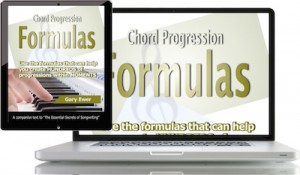On those days when you’re between songs and don’t know what to write about, you can avoid frustration — and ultimately writer’s block — if you change your focus and work on some songwriting exercises.
The end result of a songwriting exercise is usually a fragment — a fragment that might or might not ever work its way into one of your songs. The value in creating these fragments is the training your musical mind, training that will help you create future songs with more ease.
 “Chord Progression Formulas” shows you a system for creating your own progressions in seconds using some basic formulas, in both major or minor keys. It’s available at the Online Store.
“Chord Progression Formulas” shows you a system for creating your own progressions in seconds using some basic formulas, in both major or minor keys. It’s available at the Online Store.
There are lots of different kinds of exercises that might help. Some involve speedwriting (check out “The Many Benefits of Speedwriting Your Songs“), some might require you to focus on one or another specific song element (“4 Fun Games to Hone Your Lyric-Writing Abilities“), and they’re all meant to polish your musical instincts and make you a better songwriter in the long run.
As you likely know, contrast is a vital part of songwriting/musical success. Loud/soft, high/low, full/transparent… there are many ways that songs present opposite characteristics in close proximity, and we love hearing those contrasts.
So we love the loud raucous intro of “Smells Like Teen Spirit” which then suddenly gives way to a very transparent, quieter verse, and back to a loud, energetic chorus.
We love the low verse melody of Tom Petty’s “Free Fallin'” which then jumps an octave higher for the chorus.
We love when opposites take their time as well. We love the long, slow build of “Shallow” (Lady Gaga, Andrew Wyatt, Anthony Rossomando, Mark Ronson), and love how the constant build grabs our emotions and pulls them along with it.
Sometimes opposites are a result of production-level decisions, but you can also create opposites as a songwriting exercise. Here are a few ideas for working on creating musical fragments by considering opposites:
Lyrics
The most obvious opposite we present in typical song lyrics is the contrast of narrative-style with emotional. So try this: Think up a song topic (don’t obsess over this… anything will do: a break-up, love for your child, world peace… that sort of thing). And now write two quick lyrics, a verse-type lyric that tells a part of a story, and then contrast it with a more emotional, reaction-style lyric that you might find in a chorus.
Example:
Verse (narrative style):
You told me not to wait around any more,
It’s time to move on, time to walk out the door… [etc.]
Chorus (emotional, reaction style):
How do I keep from going insane?
Don’t toss me aside, there’s nothing to gain… [etc.]
Melody
Of the many ways you can create opposites in melody-writing, try this one:
Create a simple chord progression, something like:
C Dm F C | C Dm F C | Am F G Am | C Dm F C I ii IV I | I ii IV I | vi IV V vi | I ii IV I
Now create two melodies, 1) one that sits relatively low in pitch and avoids the tonic note; and 2) one that sits relatively high and features the tonic note as an important beginning and/or ending.
The low one would work as a verse melody and the high one as a chorus. There are other ways to practice your melody-writing skills; for example, try starting on a high note and work your way downward. Now go through the progression again, starting on a low note and work your way upward.
Chord Progressions
The most obvious opposite with regard to chords is to contrast major with minor. In the progression above, you’ll notice that the third phrase switches focus to minor (Am F G Am), and it creates a pleasant sense of contrast that keeps the entire fragment from becoming a boring repetition.
Try transposing a short progression higher or lower, even into a new key. Something like this:
C F G C |Am Dm Em Am|| or…
C F G C |Eb Ab Bb Eb
Opposites have a way of grabbing a listener’s attention in very positive ways. Opposites can create musical momentum that makes us extremely curious and want to keep listening.
For each of the ideas above, don’t worry about writing a full song, but be aware that some of your ideas will be enticing enough to include in a future song you’ll be working on, so be sure to record/document everything you do, and keep those ideas!
 Written by Gary Ewer. Follow Gary on Twitter
Written by Gary Ewer. Follow Gary on Twitter
 It’s time to declutter your songwriting process. “The Essential Secrets of Songwriting” eBook Bundle packages can help you become a more efficient, prolific songwriter. Get today’s 10-eBook Deluxe Bundle deal: a free copy of “Use Your Words! Developing a Lyrics-First Songwriting Process”
It’s time to declutter your songwriting process. “The Essential Secrets of Songwriting” eBook Bundle packages can help you become a more efficient, prolific songwriter. Get today’s 10-eBook Deluxe Bundle deal: a free copy of “Use Your Words! Developing a Lyrics-First Songwriting Process”











Yes DYNAMICS in melody writing are so important , someone compared it
to the speeches of Adolf Hitler , where his tone coupled with an increase of
volume keeps ones audience listening , and Hitler was very clever in that
respect . Sadly in his case it caused the death of millions of people
But used in Song writing it can help to sell millions as opposed to giving
your recordings away for nothing, when know one wants to buy them
Far too many Demos are sent tp Publishers and Pro Singers that sound
like a metronome with no melodic contrast in tempo or vocal range